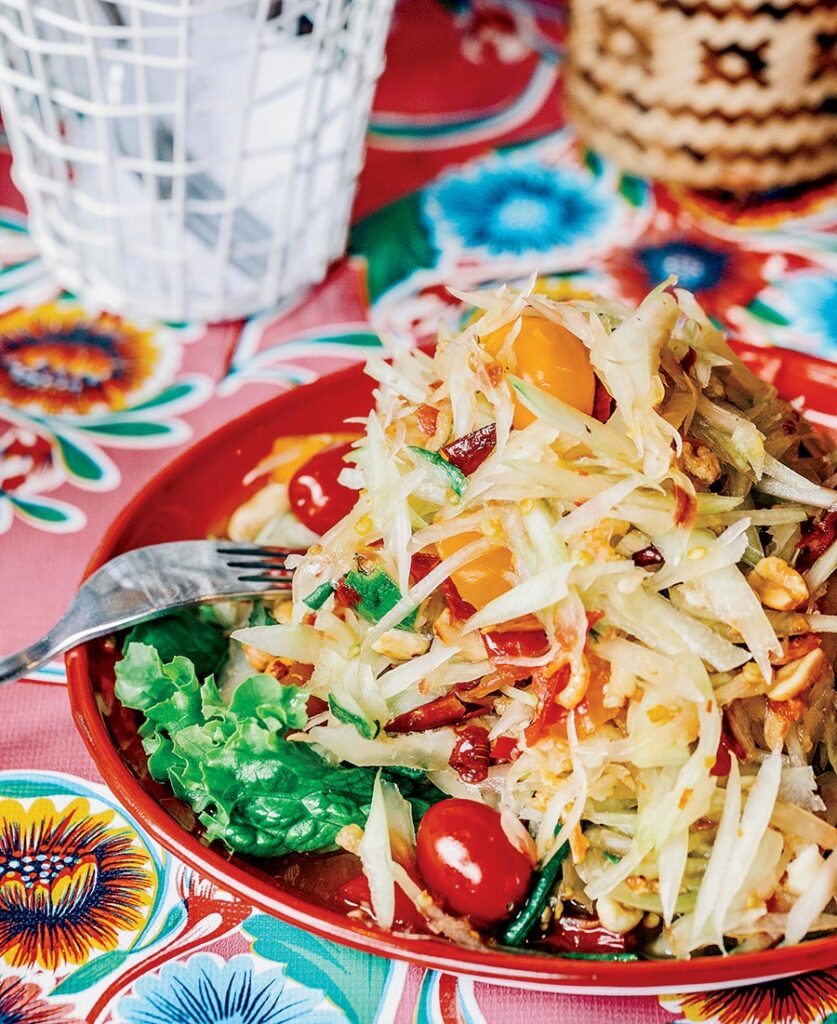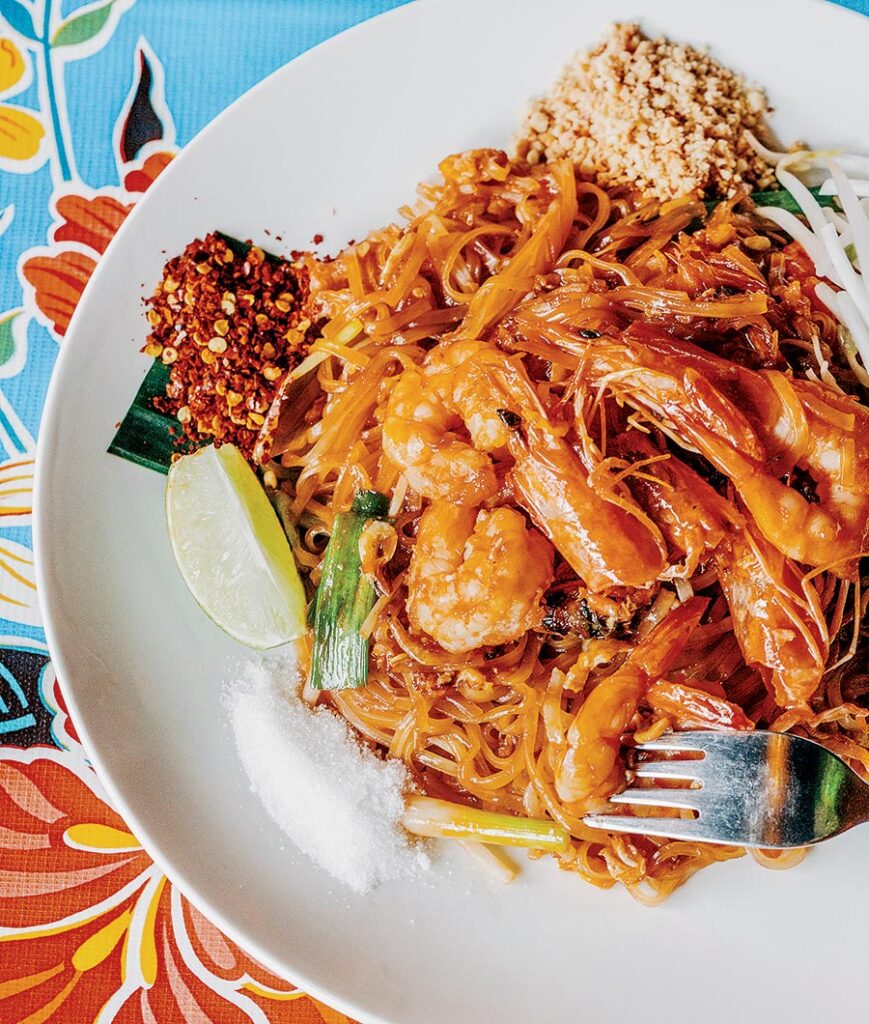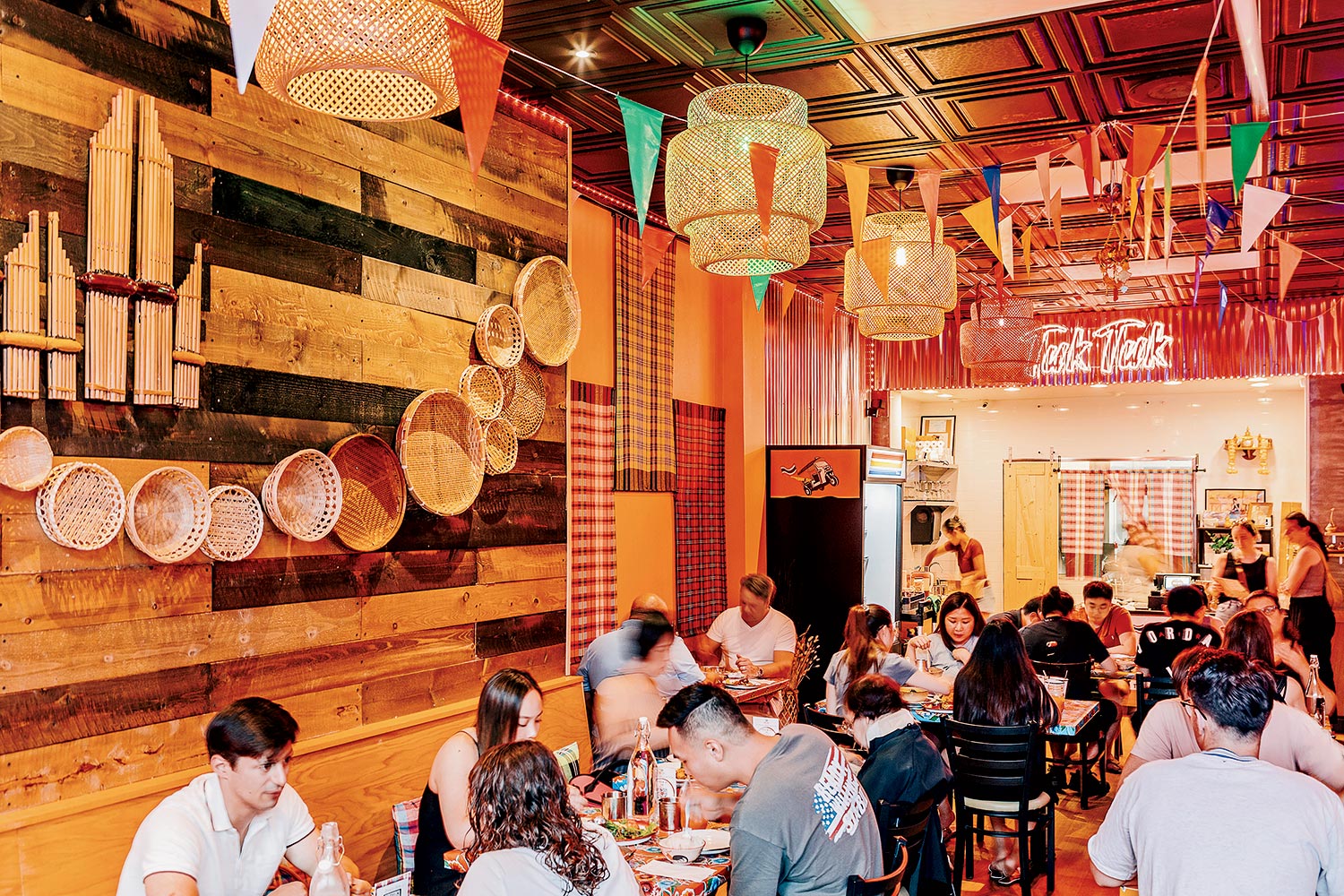The green papaya salad was a showstopper. That is not a sentence I thought I’d ever write. The dish often plays second fiddle in a Thai meal, a bracing, crisp bite, the counterpoint to creamy curry and pad thai. But here it is: a bell-shaped mound of papaya — a riotous, juice-drenched tangle of green shreds pounded with fiery rings of red chile, tomatoes, peanuts, briny dried shrimp no larger than a grain of rice, and the spent halves of limes that surrendered their juices to this amazingness.
I guess it’s no surprise that this salad and its many variations should steal the show, because if there’s one dish that serves as a calling card to Isan cooking, this is it. As its name makes clear, Tuk Tuk Thai Isan Street Food focuses on the remarkable cuisine from the Isan region of northeast Thailand — that bulbous part far from the big cities, bordered by Laos to the north and Cambodia to the south.
A few notes on Isan cooking: First, it is pungent, funky, and dead-ass spicy. There’s a great word in Thai to describe these qualities: zap. Second, you may already know some Isan dishes. Think about nam tok (slivers of grilled meat dressed as a salad with raw veggies) and all the variations of laab (ground meat bathed in lime juice, fish sauce, and roasted rice powder). Third, people all over Thailand love Isan food the way people all over the U.S. love Southwestern food. A lot of émigrés from this poor, rural region decamped to Thailand’s big cities for opportunity and brought their foodways with them. Many found work as street food vendors. You can oftentimes tell the Isan stalls by their braziers with sizzling meat dripping fat over coals and by the giant mortars the cooks use to pound dressings to order. That’s the heart of it: Isan food tingles with energy.

So does Tuk Tuk. Named for the motorized three-wheelers that noisily ferry passengers around Bangkok, this restaurant is designed to feel like you’ve arrived at a busy stall in a night market. Its walls are a color-drenched mishmash of corrugated aluminum siding, woven hand baskets, and stacks of Thai packaged goods; rainbows of paper lanterns hang overhead. The food will take you there as well, though it is at its best when you focus on the vibrant salads and soups. The pick-a-protein selection of curries and entrées can suffer from lesser-quality ingredients.
The Lake View East restaurant is a trip home for the married owners, Por Ratchapol Treedamrongrit and Molly Narumon Sutthitham. For five years, the couple have helmed Lincoln Park’s Green Tea Japanese Restaurant, the sort of venue for crunchy rolls and teriyaki that makes for sound business for many Asian restaurateurs. But Treedamrongrit got to talking with a friend and fellow Thai Isan, Pond Teradret Visavavilavon, and together the trio decided they were ready to offer the kind of street food they personally longed for. Would Chicagoans bite? Apparently so. The dining room fills quickly on a busy night. We’ve had to wait a few minutes for service twice, but it gave us time to peruse the distinctive menu and make some hard choices.
Here’s my advice: Your first order of business should be determining which of the eight items listed as papaya salad to try. The basic tum thai is a fine place to start, though if you’re up for a little funk, you can upgrade to tum thai and poo, which includes inch lengths of preserved raw crab to give the dressing a savory dimension. Not all these salads contain papaya; tum kao pod subs in sweet raw corn, pebbly lashings cut right off the cob, and it’s as delicious as it sounds. If you want to eat like you do in Isan, ask for some sticky rice on the side to mop up the dressing with your fingers. You might also order it Thai hot (5 on the 1-to-5 scale), but 3 is as much as I can tolerate, and I can generally eat food that melts friends’ faces.
Next pay close attention to the section labeled “yum zap,” which are spicy meat salads. Laab moo krob contains cubes of tender, crisped pork belly that have been rendered to a near-fatless crisp. That’s my pick, but others with ground chicken or surprising beef-rice meatballs have their charms.

There are specialties of the house that taste very unlike those of other houses. Talay pad pong karee brings together squid and gorgeous shrimp (peeled but with the heads still attached) in a creamy egg curry sauce, a lush emulsion like great carbonara. The same shrimp headlines the “signature” pad thai, set on a plate with all its components (noodles, pickled radish, chile powder, sugar, dried shrimp) ready to mix together.
Why, then, does the regular pad thai — as well as most items from the entrée section — use shrimp that is pink and translucent from chemical treatment? Other lesser ingredients can bum your yum, from weirdly velvetized beef to a deep-fried red snapper (at $29, the most expensive item on the menu) that is bony, leathery, and not worth the struggle. Nor is the usually reliable kai yang, which here is not roast chicken but instead lightly grilled whole wings, the tensile strength of their skin as sproingy as rubber bands.
So in lieu of those, order another salad or try the tom zaap soup, which smells like the spice market you’d encounter during a guided psychedelic experience. And save room to end with the kanom tuay. It’s a trio of coconut and pandan custards that are served hot from the steamer in rounded ceramic cups. Perhaps it will bring you back to the time you ate it in a night market on a trip to Thailand. Lacking that, it can certainly stoke your imagination. When Tuk Tuk leans into its roots, it gives you a transportive experience that will leave you thinking as I did: that dining here is mostly zap.



